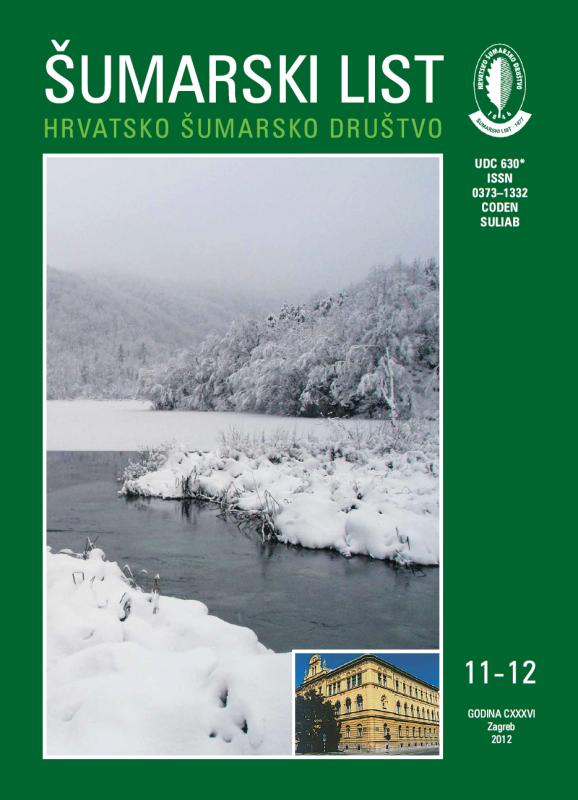
broj: 11-12/2012
pdf (4,44 MB) |
|
||||||||||||||
| RIJEČ UREDNIŠTVA | ||
| Uredništvo | ||
| AT THE END OF THE YEAR pdf HR EN | 557 | |
| IZVORNI ZNANSTVENI ČLANCI | ||
| Jozo FRANJIĆ, Željko ŠKVORC, Daniel KRSTONOŠIĆ, Krunoslav SEVER, Ivana ALEŠKOVIĆ | UDK 630*165+187 (001) | |
| VEGETATION FEATURES OF LITTORAL BEECH FORESTS (Seslerio autumnali-Fagetum M. Wraber ex Borhidi 1963) AND PREMONTANE BEECH FORESTS (Ranunculo platanifoliae-Fagetum Marinček et al. 1993) IN THE AREA OF UČKA NATURE PARK pdf HR EN | 559 | |
| Marilena IDŽOJTIĆ, Marko ZEBEC, Igor POLJAK, Zlatko ŠATOVIĆ, Zlatko LIBER | UDK 630*165 (Castanea sativa Mill.) (001) | |
| ANALYSIS OF THE GENETIC DIVERSITY OF "LOVRAN MARRON" (Castanea sativa Mill.) USING MICROSATELLITE MARKERS pdf HR EN | 579 | |
| Dalibor BALLIAN, Faruk BOGUNIĆ, Osman MUJEZINOVIĆ, Davorin KAJBA | UDK 630*165 (Fagus sylvatica L.) (001) | |
| GENETIC DIFFERENTIATION OF EUROPEAN BEECH (Fagus sylvatica L.) IN BOSNIA AND HERZEGOVINA pdf HR EN | 589 | |
| PRETHODNO PRIOPĆENJE | ||
| Stefan WIRTH Milan PERNEK | UDK 630*443 | |
| FIRST RECORD OF THE MITE Histiostoma ulmi IN SILVER FIR AND INDICATION OF A POSSIBLE PHORETIC DISPERSAL BY THE LONGHORN BEETLE Acanthocinus reticulatus pdf HR EN | 599 | |
| Abstract: The mite Histiostoma ulmi (Histiostomatidae), originally discovered by the describer within the bark beetle galleries of genus Scolytus, has been found to be phoretic on a tenebrionid beetle Hypophloeus bicolor. The first discovery of H. ulmi in the galleries of the longhorn beetle Acanthocinus reticulatus indicates the possibility of its phoretic association with several beetle carriers: tenebrionid, cerambycid and scolytid beetles. In Croatia, scolytids of the genus Pityokteines, occupying the same niche within their food plant, silver fir (Abies alba) could represent these additional carriers. Acanthocinus reticulatus infested the bark of an Abies alba specimen as a pioneer taxon, as opposed to the usual earliest colonising beetles Pityokteines spinidens and P. curvidens. Histiostoma ulmi was reared from samples taken from the galleries of this longhorn beetle’s larvae. As is typical for histiostomids, these mites feed on bacteria. They represent a monophyletic group of at least six very similar species. The morphological characters separating H. ulmi from similar species are expressed only in adult mites. Deutonymphs found attached to Pityokteines were previously determined to be Histiostoma piceae, but were never reared to adulthood. Due to a close resemblance between the deutonymphs of H. piceae and H. ulmi, incorrect assignments, relying only on deutonymphs for determination, are possible. H. ulmi was observed under laboratory conditions carrying spores of an undetermined mold fungus. Other phoretic mites, such as Tarsonemus, are known to carry spores of blue stain fungi (Ophiostomatidae) which could be of practical importance in silver fir decline. Future studies need to show, whether deutonymphs of H. ulmi, possible vectored by bark beetles, tenebrionids and longhorn beetles, also carry spores of blue stain fungi. Key words: Pityokteines; Acari; Histiostomatidae; Histiostoma ulmi; Histiostoma piceae; Acanthocinus reticulatus; fungal spores; hyperphoresy | ||
| STRUČNI ČLANCI | ||
| Damira TAFRA, Marija PANDŽA, Milenko MILOVIĆ | UDK 630*174 | |
| WOODY PLANTS OF THE OMIŠ pdf HR EN | 607 | |


